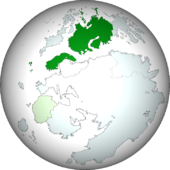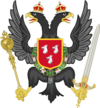Atmora
This article is incomplete because it is pending further input from participants, or it is a work-in-progress by one author. Please comment on this article's talk page to share your input, comments and questions. Note: To contribute to this article, you may need to seek help from the author(s) of this page. |
Atmoran Confederation Atmoraanse Statenbond | |
|---|---|
 Location of Atmora in Green, and within the Union State. | |
| Capital | Alexandria |
| Largest city | Pruzhana |
| Official languages | Dutch |
| Recognised regional languages | English • Mizuhese • Spanish • Vozhski • Voshanskya |
| Ethnic groups (2015) |
|
| Religion |
|
| Demonym(s) | Atmoran |
| Government | Federal parliamentary constitutional monarchy |
• Monarch | Katherine II |
| Lysithea van Hresvelg | |
| Legislature | Parliament |
| Senate | |
| House of Representatives | |
| Independence from the Hespirese Empire | |
• Atmoran Unification | 15 December, 1812 |
• Confederation | 6 January, 1813 |
• Constitution | 13 May 1813 |
| Area | |
• | 8,444,958 km2 (3,260,617 sq mi) (2nd) |
| Population | |
• 2015 estimate | 253,238,014 (2nd) |
• 2015 census | 253,238,014 |
• Density | 29.987/km2 (77.7/sq mi) |
| GDP (PPP) | 2015 estimate |
• Total | $13.865 trillion |
• Per capita | $54,751 (2nd) |
| GDP (nominal) | 2015 estimate |
• Total | $13.865 trillion (2nd) |
• Per capita | $54,751 |
| Gini (2015) | 18.68 low · 1st |
| HDI (2015) | very high · 2nd |
| Currency | Atmoran Guilder (Aƒ) (ATG) |
| Date format | dd/mm/yyyy (CE) |
| Driving side | right |
| Calling code | +1 |
| Internet TLD | .at |
Atmora (/'ətmôrə/), officially the Atmoran Confederation (Dutch: Atmoraanse Statenbond), is a federal parliamentary constitutional monarchy laying in the western Halkeginia bordered to the East by Vozh and to the Southeast by Ryurik Rossiya, across the Castarcian Sea in the west by Castarcia. It includes 18 constituent states, covers an area of 8,444,958 square kilometres, and has a largely temperate seasonal climate. With about 253.2 million inhabitants, Atmora is the most populous states in Halkeginia and the Halkeginian Sea. After Aravea, it is the third most popular immigration destination in the world. Atmora's capital and second largest metropolis is Alexandria, while it's largest city is Pruzhana.
Etymology
While manying have debated the orgins of Atmora, the name is widely believed to have come from the Caerenic people in Brunna region of Lieseltania which they named "Allt Mór", meaning "Great Valley". By the time of the Lieseltan conquest of Atmora in 57 BCE later used the word Atmore to describe not only the Brunna region but the entire Atmoran continent. By the 14th century Luxian explorers later called it by Atmora.
History
Prehistory and antiquity
The first known human settlements into western Halkeginia what is now modern day Atmora dates back 36,000 years ago. When the First Nations acrossed the Chukotka Mountains (Tsjoekotka-gebergte) into the modern day Voshagne region. As the First Nations people were driven out from their eastern Halkeginian lands by the large influx of Slavonic and Celtic peoples arriving through the land bridge between Halkeginia and Rohane.
One the earliest known civilisations in Atmora were the Salishans, a confederacy of Coast Salish and Interior Salish tribal groups who settled around the White Karth and Black Karth rivers. Around 2700 BCE the city of Somena was founded as the seat of the Salishan river civilisations, in what is now modern day Alphen aan den Karth, Lieseltania. The Salishans largely controlled what is now the modern day Lieseltanian provinces of The Karth, Pruzhana, Wolf, and parts of the province of Siletzia. By 1700 CE the Tahkaht and the Tasekoans rebelled against the Salishans.
The Tahkaht civilisation was a confederacy of Nuu-chah-nulth and the Kwakwakaʼwakw centered around the city of Kitsuksis modern day Amstenrade, Lieseltania. The Tahkaht would end up controlling a most of the western Lieseltanian Peninsula and even parts of the Siletzian river valley. Fighting between the Tahkaht and the Salishans were common, especially for control over the Bay of Pruzhana, to secure the trading routes with the east.
Around 901 CE the Old Lieseltanians and the Jarengans two slavic tribe from Vozh had acrossed the Chukotka mountains. The Jarengans settling the north establishing the city of Brunna and Castamere in 976 CE. The Jarengans were the first non-FNs peoples to have crossed the Diebal mountains into what is now the modern day provinces of Voznesenka and Kivalina. The Old Lieseltanians had settled around the Bay of Pruzhana establishing the city of Pruzhana in 908 CE, the Old Lieseltanians would remain under vassalage of the Salishans till the 11th century.
Around the turn of the 12th century Helgmundr Altmurasz a Gambrean explorer from Southern Auricia had left his homeland of Gambria, hearing tales of men as tall as trees.
Spanish Atmora
Most of the southern Atmora and the entire Asvarrese peninsula were either under personal union or vassal states of John II, the King of Castile and Leon and the Halkeginian Emperor in 1387. Organised into the Fifteen Provinces in 1431 by Halkeginain Emperor Charles I of Hespira, along with the vassal states of the Principality of Wolf, Duchy of Lieseltania, Grand Duchy of the Karth, Principality of Randgriz, Duchy of Larsenburg, and the Principality of Vianen.
In 1524 the the Princiaplity of Wolf and the Duchy of Lieseltania merged into a single state known as the Grand Duchy of Wolf-Lieseltania, at the height of tensions between Grand Duke Jurgen II of Lieseltania and Halkeginian Emperor Phillip II of Hespira. Occured the Castenray massacare in which the Hespirese Army of Halkeginia in May 1524 had suppressed the rebellion of the Atmoran peasants in the County of Castenray in modern day Larsenburg. In which it is believed that almost 97% of the city of Castenray was destroyed. The Massacre of Castenray had left a great rift between the local Halkeginian lords and the Halkeginian Emperor's court in Madrid. By December 1527, Atmoran lords and princes had gathered at the Congress of Castelré in which they issued the Act of Abjuration beginging the Atmoran revolt against the Halkeginain Emperor. Two years later in 1529 the Halkeginian Emperor had responded to the Atmoran Act of Abjuration by sending the Hespirese Armada into the Bay of Pruzhana, shelling the city of Pruzhana in 17 May 1529.
Following the Battle of the Pruzhana Bay, the Grand Duchy of Wolf-Lieseltania, Principality of Randgriz, Duchy of Larsenburg, Principality of Vianen, Duchy of Huldenberg, and the Fifteen Provinces had declared independence from the Hespirese Empire in 21 May 1529 starting the War of Atmoran Independence.
War of Atmoran Indepedence and Wolvinsch Empire
Atmoran Confederation
Fascist Atmora and the Third Voshan War
Contemporary era
Geography
Flora and Fauna
Climate
Environmental Issues
Government and politics
Atmora is a federal parliamentary constitutional monarchy. High Queen Katherine II is the monarch and head of state of Atmora—being the foundation of the executive, legislative, and judicial branches of the Atmoran Government. The monarch's powers is limited and in practice, the use of the executive powers is directed by the Cabinet. The cabinet is responsible to the elected Parliament of Atmora and chosen and headed by the chancellor (at present Lysithea van Hresvelg), the head of government. The monarch may, though, in certain crisis situations exercise their power without ministerial advice. The monarch in practice normally appoints the leader of the party that can obtain the confidence of a plurality in the House of Representatives of Atmora.
The monarch appoints all ministers of the Crown, military officers, public offices, and so forth. Usually however the monarch will appoint the nominees from her ministers.
The Government is comprised of three branches:
- Legislative: the bicameral Parliament of Atmora, made up of the Senate (upper house) and the House of Representatives (lower house) who are elected by the constituents of their states.
- Executive: the Privy Council and the Council of Ministers, are in which executive powers are exercised. With the Chancellor and Cabinet being appointed members of both the Privy Council and Council of Ministers by the monarch.
- Judiciary: the Supreme Court of Atmora, headed by the President of the Supreme Court of Atmora and lower federal courts, whose judges are appointed by the Monarch
In the Senate, there are 158 senators; 142 from all the states and 16 from the territories. The House of Representatives has 528 members elected from constituencies from the States and territories, allocated on the basis of population of the states and territories.
Administrative Divisions
Atmora is a federation of eighteen constituent states. These states consitent of kingdoms, grand duchies, duchies, and principalities. States are then divided into provinces (provinciën), which then are divided into arrondissements (arrondissementen), then further down into municipalities (gemeenten). States of Asvarre, Alsatia, and Lippe on the Asvarrese peninsula are divided into arrondissements and municipalities.
- States
A list of eighteen states and each state capital (in brackets):
- Kingdoms
- Grand Duchies and Duchies
- Principalities
Alsatia (Straatsburg)
Doorn (Austerlitz)
 Leuven (Briast)
Leuven (Briast)Lippe (Bern)
Largest Cities
Largest Cities in Atmora
Atmoran Census Bureau | |||||||||
|---|---|---|---|---|---|---|---|---|---|
| Rank | State | Pop. | Rank | State | Pop. | ||||
 Pruzhana  Melvere |
1 | Pruzhana | Lieseltania | 7,479,225 | 11 | Meurs | Brunswijk | 1,194,734 |  Alexandria, Lieseltania  Florennes |
| 2 | Melvere | Larsenburg | 5,792,621 | 12 | Mentz | Larsenburg | 1,081,795 | ||
| 3 | Alexandria, Lieseltania | Lieseltania | 4,295,929 | 13 | Nisse | Lieseltania | 1,032,861 | ||
| 4 | Florennes | Asvarre | 3,979,576 | 14 | Noorvik | Huldenberg | 986,409 | ||
| 5 | Vianen | Brunswijk | 3,695,598 | 15 | Castelré | Guldenhof | 971,927 | ||
| 6 | Brugge | Gallia | 2,967,452 | 16 | Saint Annasburg | Lieseltania | 961,386 | ||
| 7 | Anthold | Lieseltania | 2,745,942 | 17 | Koningsberg | Lieseltania | 943,461 | ||
| 8 | Ottenburg | Huldenberg | 1,624,702 | 18 | Brühl | Lieseltania | 916,231 | ||
| 9 | Novigrad | Lieseltania | 1,467,452 | 19 | Meissen | Lieseltania | 871,621 | ||
| 10 | Moeskroen | Gallia | 1,259,627 | 20 | Castalien | Asvarre | 846,345 | ||
Foreign Relations
Atmora is recognised as a regional power within Halkeginia and greater Halkeginian Sea area. Due to it's massive military and economic size in comparison to it's neighbouring nations. Under the Chancellorship of Lysithea van Hresvelg, Atmora has sought close ties and intergation with it's neighbours. Funding massive infrastucture projects like the Pan-Halkeginian Railway, the International H-Autobaan Network, Castarcian Sea Tunnel, the Halkeginian Sea Tunnel. Atmora wishes to establish the Halkeginian Union with Castarcia, Vozh, Hespira, Mizuho, and Ryurik Rossiya however meets significant roadblocks in uneasiness of suspected Atmoran dominnance over such an Supranational union.
One the greatest challengers of Atmoran influence in Halkeginia is Aravea, who sees Atmora's rise of influence in Halkeginia as a threat to Aravea's interests within the region. As result these two great powers are locked within a cold war with one another. Ever since the end of the Third Voshan War, Atmora has felt as if Aravea is trying to contain Atmora within their own borders. As Aravea was a major contributor to the decolonisation of the Atmoran Empire, leaving only Mizuho as the last remnants of the Empire. While Aravea and Atmora have begun talks over deescalation between the two states, the War of Ghelen as remained a continuing issue amongst the two states. Since the Aravean Civil War in 1863 till 1946, Atmora held onto the county of Ghelen as a Crown Colony of the Atmoran Empire. Following Atmora's defeat in the Third Voshan War, the county was granted indepedence from Atmora. However insurgents within Ghelen have resisted efforts by the Government of Aravea in reunification. Atmora continues to recognise Ghelen as an indepedent state with David Westenberg, as the Atmoran Ambassador to the Republic of Ghelen. Along with the Olov Malmberg in 2014, handing his credentials to the High Queen in Alexandria as the Ghelen Ambassador to the Atmoran Confederation.
Since the decolonisation of the Atmoran Empire, Atmora and Mizuho have formed the Union State of Atmora and Mizuho (USAM), a confederation between the two states with the monarch of Atmora as the Head of the Union.
Military
The Atmoran Armed Forces, officially, the Her Majesty's Armed Forces which consists of three professional service branches administered by the Department of National Defence: the Atmoran Army the Royal Atmoran Navy, the Royal Atmoran Air Force. The commander-in-chief is the Atmoran Monarch, currently High Queen Katherine II, to whom members of the forces swear an oath of allegiance. The roles each branch is allowed to fill and the equipment they are allowed to operate is managed by the Department of National Defence (MND), and roles are regularly updated with changes in strategy, as well as tactical advancements.
TBA
Economy
Demographics
Education
Ethnicity
Ethnic groups of Atmora (Census 2080)
Historically Atmorans have identified with their regional identity than as apart of a greater Atmoran peoples. It wasn't until the age of enlightment that led towards the volksgemeenschapszin movement within the Atmoran states, along with the Atmoran Revolutions of 1750 were a greater Atmoran identity had begin to be formed. Additionally with almost 70% of Atmorans living within states ruled by the House of Wolf, a Wolfisch movement within Wolfsch states to further intergate helped further increase a call for an Atmoran state.
According to the 2015 Atmoran census by the National Institute for Statics: 76.3% identify as Atmoran (193.2 million), 7.8% as Voshany (19.7 million), 6.3% as Slavonic (15.9 million), 5.1% as First Nations (12.9 million), 2.9% as Mizuhese (7.3 million), and finally 1.6% identifying as others.
The largest ethnic group within Atmora are the Atmorans who make up about 193.2 million, largely an amalgamation of various Dutch speaking subethnic groups within Atmora. The second largest group within Atmora are the Voshany who are descendended from the intermingely of Noordatmoraanse with the local Slavonic and First Nations population in Northern Lieseltania, today the Voshany make up a population of 19.7 million, but is estimated that 93.7 million Atmorans are to be descended from Voshany or Slavonic ancestors.
The third largest ethnic group in Atmora are the Slavons who make up a population of 15.9 million. 67.9% of the Slavonic population is ethnically Vozhsky (10.8 million). 17.1% as Angaran Cossack (2.7 million), 7.3% as ethnically Wends (1.2 million), 5.8% as ethnically Diebalsky (925.3k), and 1.9% as other minor Slavonic groups (303.1k).
The fourth largest ethnic group in Atmora the First Nations who make up a population of 12.9 million are the one of the oldest indigenous peoples of Halkeginia. The first nations are generally spilt into three seperate groups First nations, Mesties, and the Inuit/Joepiks tribes. There are 9.3 million First nations people with Atmora, of various different tribal groups within Atmora making up 72.3% of the FN population. The Mesties make up 27.5% of the First nations population, and are a descendants of Atmoran/Slavonic men with First Nation women in the Karth-Siletzian region, in total they make up a population of 355.2k. The smallest first nations group within Atmora reside along the Sidnese Sea the Inuit and Joepiks who make up 1.2% of the FN population or roughly 154.9k people.
Religion
Religions in Atmora (2015)
Languages
TBD






